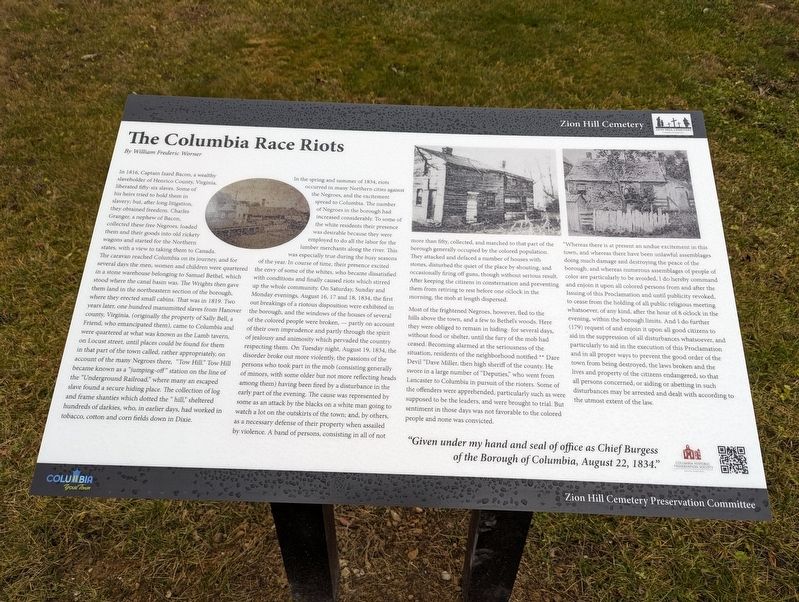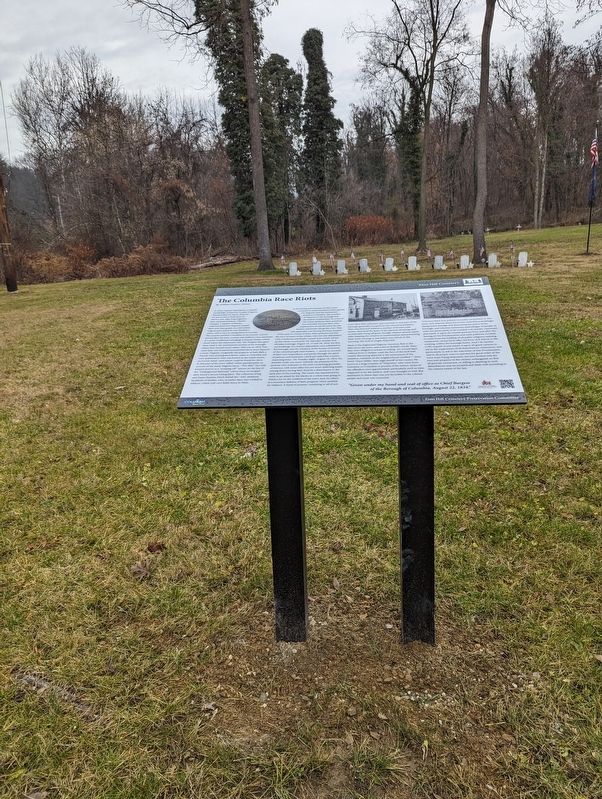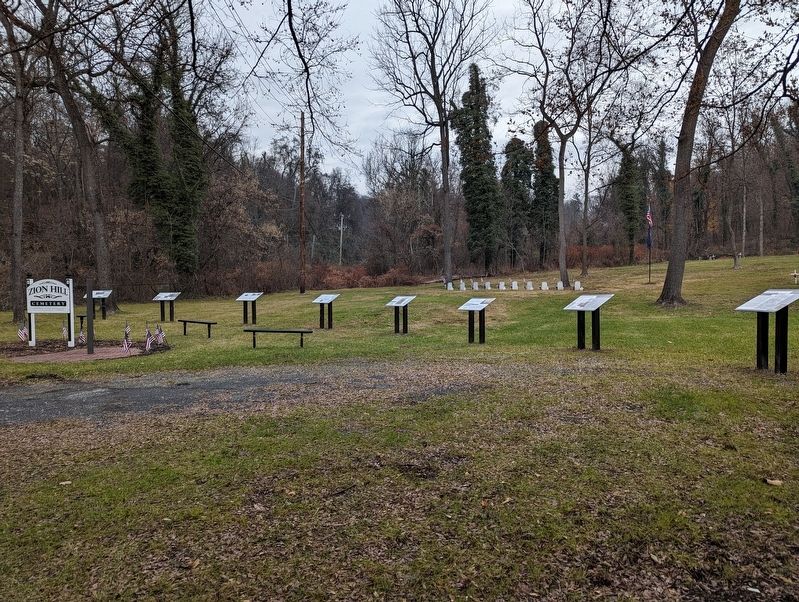Columbia in Lancaster County, Pennsylvania — The American Northeast (Mid-Atlantic)
The Columbia Race Riots
In 1816, Captain Izard Bacon, a wealthy slaveholder of Henrico County, Virginia, liberated fifty-six slaves. Some of his heirs tried to hold them in slavery; but, after long litigation, they obtained freedom. Charles Granger, a nephew of Bacon, collected these free negroes, loaded them and their goods into old rickety wagons and started for the Northern states, with a view of taking them to Canada. The caravan reached Columbia on its journey, and for several days the men, women and children were quartered in a stone warehouse belonging to Samuel Bethel, which stood where the canal basin was. The Wrights then gave them land in the northeastern section of the borough, where they erected small cabins. That was in 1819. Two years later, one hundred manumitted slaves from Hanover county, Virginia (originally the property of Sally Bell, a Friend, who emancipated them), came to Columbia and were quartered at what was known as the Lamb tavern, on Locust street, until places could be found for them in that part of the town called, rather appropriately, on account of the many Negroes there, "Tow Hill". Tow Hill became known as a "jumping-off" station on the line of the "Underground Railroad," where many an escaped slave found a secure hiding place. The collection of log and frame shanties which dotted the "hill," sheltered hundreds of darkies, who, in earlier days, had worked in tobacco, cotton and corn fields down in Dixie.
In the spring and summer of 1834, riots occurred in many Northern cities against the Negroes, and the excitement spread to Columbia. The number of Negroes in the borough had increased considerably. To some of the white residents their presence was desirable became they were employed to do all the labor for the lumber merchants along the river. This was especially true during the busy seasons of the year. In course of time, their presence excited the envy of some of the whites, who became dissatisfied with conditions and finally caused riots which stirred up the whole community. On Saturday, Sunday and Monday evenings, August 16, 17 and 18, 1834, the first out breakings of a riotous disposition were exhibited in the borough, and the windows of the houses of several of the colored people were broken, partly on account of their own imprudence and partly through the spirit of jealousy and animosity which pervaded the country respecting them. On Tuesday night, August 19,1834, the disorder broke out more violently, the passions of the persons who took part in the mob (consisting generally of minors, with some older but not more reflecting heads among them) having been fired by a disturbance in the early part of the evening. The cause was represented by some as an attack by the blacks on a white man going to watch a lot on the outskirts of the town; and, by others, as a necessary defense of their property when assailed by violence. A band of persons, consisting in all of not more than fifty, collected, and marched to that part of the borough generally occupied by the colored population. They attacked and defaced a number of houses with stones, disturbed the quiet of the place by shouting, and occasionally firing off guns, though without serious result. After keeping the citizens in consternation and preventing them from retiring to rest before one o'clock in the morning, the mob at length dispersed.
Most of the frightened Negroes, however, fled to the hills above the town, and a few to Bethel's woods. Here they were obliged to remain in hiding - for several days, without food or shelter, until the fury of the mob had ceased. Becoming alarmed at the seriousness of the situation, residence of the neighborhood notified Dare Devil "Dave Miller, then high sheriff of the county. He swore in a large number of "Deputies," who went from Lancaster to Columbia in pursuit of the rioters. Some of the offenders were apprehended, particularly such as were supposed to be the leaders, and were brought to trial. But sentiment in those days was not favorable to the colored people and none was convicted.
"Whereas there is at present an undue excitement in this town, and whereas there have been unlawful assemblages doing much damage and destroying the peace of the borough, and whereas numerous assemblages of people of color are particularly to be avoided, I do hereby command and enjoin it upon all colored persons from and after the Issuing of this Proclamation and until publicity revoked, to cease from the holding of all public religious meeting whatsoever of any kind after the hour of 8 o'clock in the evening, within the borough limits. And I do further (179) request of and enjoin it upon all good citizens to aid in the suppression of all disturbances whatsoever, and particularly to aid in the execution of this Proclamation and in all proper ways to prevent the good order of the town from being destroyed, the laws broken and the lives and property of the citizens endangered, so that all persons concerned, or aiding or abetting in such disturbances may be arrested and dealt with according to the utmost extent of the law.
"Given under my hand and seal of office as Chief Burgess of the Borough of Columbia, August 22, 1834."
Erected 2023 by Zion Hill Cemetery Preservation Committee.
Topics. This historical marker is listed in these topic lists: Abolition & Underground RR • African Americans • Law Enforcement • Notable Events. A significant historical date for this entry is August 22, 1834.
Location. 40° 2.394′ N, 76° 30.359′ W. Marker is in Columbia, Pennsylvania, in Lancaster County. Marker is on Chickies Hill Road south of Cedar Terrace, on the right when traveling north. The marker is in Zion Hill Cemetery. Touch for map. Marker is at or near this postal address: 553 North 5th Street, Columbia PA 17512, United States of America. Touch for directions.
Other nearby markers. At least 8 other markers are within walking distance of this marker. Zion Hill Cemetery (here, next to this marker); Columbia Underground Railroad Heritage (here, next to this marker); Free African Communities in Columbia (here, next to this marker); History of Zion Hill Cemetery (here, next to this marker); Doctress Hannah Bosley (a few steps from this marker); William Baker / Harriet Ann (Cole) Baker (a few steps from this marker); Fifth Street Colored School (a few steps from this marker); The Hair Suicide Case (a few steps from this marker). Touch for a list and map of all markers in Columbia.
Credits. This page was last revised on February 24, 2024. It was originally submitted on December 13, 2023, by William Pope of Marietta, Pennsylvania. This page has been viewed 104 times since then and 66 times this year. Last updated on February 21, 2024, by Annette Fillmore of York, Pennsylvania. Photos: 1, 2, 3. submitted on December 13, 2023, by William Pope of Marietta, Pennsylvania. • Devry Becker Jones was the editor who published this page.


